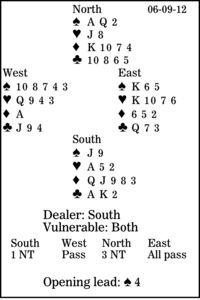Bridge column, June 9: It is time to think outside the deck

A few bridge players are like that, thinking outside the deck -- or box, if you prefer. They make bids and plays most of us never consider. Today's deal is an example. South is in three no-trump. West leads his fourth-highest spade. How should declarer plan the play?
South starts with four top tricks: one spade, one heart and two clubs. The diamond suit will provide four more winners, but declarer still needs a ninth trick from somewhere.
Obviously, if West has led from the spade king, playing low from the dummy and winning the first trick with his jack will give South an overtrick. With this layout, though, that line does not work so well. East wins with his king and, in desperation, shifts to the heart six. Then the defenders get five tricks: one spade, three hearts and one diamond.
In theory, it is no better winning the first trick with dummy's ace. When West gets in with his diamond ace, he defeats the contract by switching to a heart -- although that would not be an easy play to find.
At trick one, declarer should call for dummy's queen. If it wins, fine; the play costs only an overtrick. Here, though, East, never placing South with the spade jack, will surely win with his king and return the spade six. Then the contract is safe.
** ** **
COPYRIGHT: 2012, UNITED FEATURE SYNDICATE
DISTRIBUTED BY UNIVERSAL UCLICK FOR UFS

